Top Rankings
Kenmore-Tonawanda Union Free School District ranks among the top 20% of public school district in New York for:
Category
Attribute
Community Size
Largest student body (number of students) (Top 1%)
For the 2025 school year, there are 7 public elementary schools serving 3,784 students in Kenmore-Tonawanda Union Free School District. This district's average elementary testing ranking is 3/10, which is in the bottom 50% of public elementary schools in New York.
Public Elementary Schools in Kenmore-Tonawanda Union Free School District have an average math proficiency score of 34% (versus the New York public elementary school average of 41%), and reading proficiency score of 36% (versus the 48% statewide average).
Minority enrollment is 31% of the student body (majority Hispanic and Black), which is less than the New York public elementary school average of 61% (majority Hispanic).
Overview
This School District
This State (NY)
# Schools
10 Schools
3,702 Schools
# Students
6,270 Students
1,750,092 Students
# Teachers
615 Teachers
153,310 Teachers
Student : Teacher Ratio
10:1
10:1
District Rank
Kenmore-Tonawanda Union Free School District, which is ranked #660 of all 1,015 school districts in New York (based off of combined math and reading proficiency testing data) for the 2021-2022 school year.
The school district's graduation rate of 90% has stayed relatively flat over five school years.
Overall District Rank
#665 out of 1020 school districts
(Bottom 50%)
(Bottom 50%)
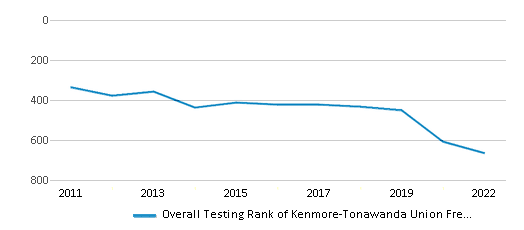
Math Test Scores (% Proficient)
43%
46%

Reading/Language Arts Test Scores (% Proficient)
37%
49%
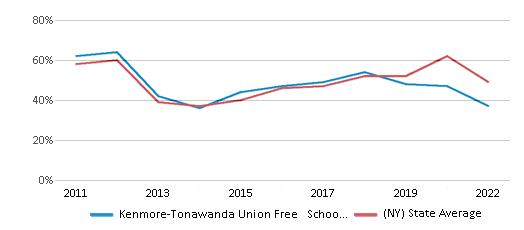
Science Test Scores (% Proficient)
80%
78%
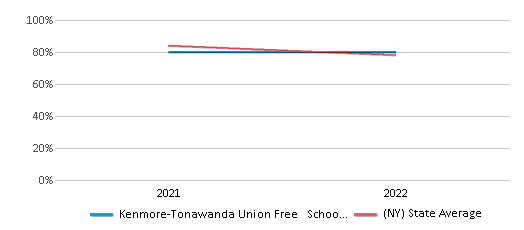
Graduation Rate
90%
87%
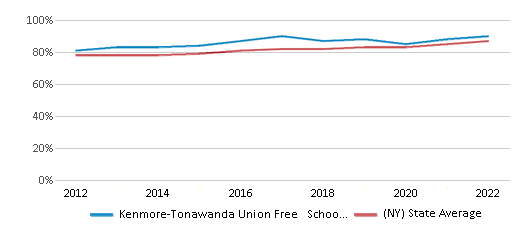
Students by Ethnicity:
Diversity Score
0.51
0.73
# American Indian Students
25 Students
14,013 Students
% American Indian Students
n/a
1%
# Asian Students
279 Students
175,821 Students
% Asian Students
4%
10%
# Hispanic Students
632 Students
531,348 Students
% Hispanic Students
10%
30%
# Black Students
547 Students
278,768 Students
% Black Students
9%
16%
# White Students
4,305 Students
682,836 Students
% White Students
69%
39%
# Hawaiian Students
3 Students
3,810 Students
% Hawaiian Students
n/a
n/a
# Two or more races Students
473 Students
63,556 Students
% of Two or more races Students
8%
4%
Students by Grade:
# Students in PK Grade:
-
60,112
# Students in K Grade:
474
169,096
# Students in 1st Grade:
470
177,074
# Students in 2nd Grade:
486
181,096
# Students in 3rd Grade:
478
177,104
# Students in 4th Grade:
491
180,516
# Students in 5th Grade:
465
181,163
# Students in 6th Grade:
467
184,038
# Students in 7th Grade:
468
161,270
# Students in 8th Grade:
466
161,773
# Students in 9th Grade:
495
24,993
# Students in 10th Grade:
523
23,859
# Students in 11th Grade:
442
21,596
# Students in 12th Grade:
517
21,027
# Ungraded Students:
28
25,375
District Revenue and Spending
The revenue/student of $27,960 in this school district is less than the state median of $31,307. The school district revenue/student has stayed relatively flat over four school years.
The school district's spending/student of $27,305 is less than the state median of $32,183. The school district spending/student has stayed relatively flat over four school years.
Total Revenue
$175 MM
$78,541 MM
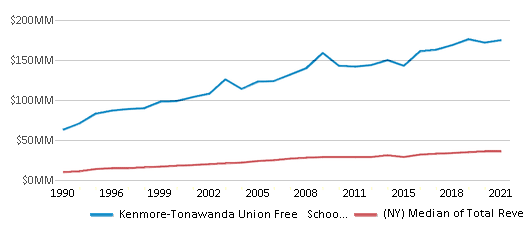
Spending
$171 MM
$80,737 MM
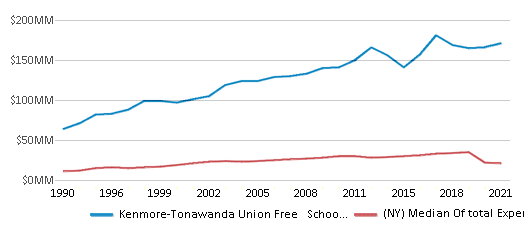
Revenue / Student
$27,960
$31,307
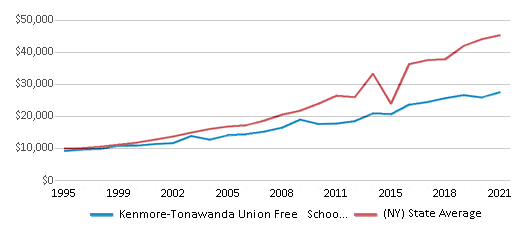
Spending / Student
$27,305
$32,183
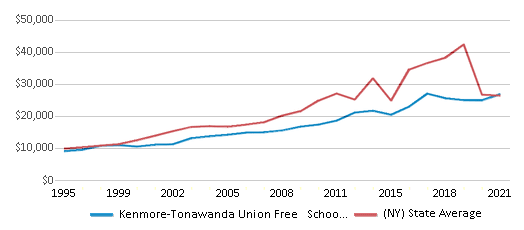
Best Kenmore-Tonawanda Union Free School District Public Elementary Schools (2025)
School
(Math and Reading Proficiency)
(Math and Reading Proficiency)
Location
Grades
Students
Rank: #11.
Charles A Lindbergh Elementary School
(Math: 50-54% | Reading: 45-49%)
Rank:
Rank:
6/
Top 50%10
184 Irving Ter
Buffalo, NY 14223
(716) 874-8410
Buffalo, NY 14223
(716) 874-8410
Grades: K-4
| 463 students
Rank: #2 - 32. - 3.
Herbert Hoover Elementary School
(Math: 35-39% | Reading: 35-39%)
Rank:
Rank:
4/
Bottom 50%10
199 Thorncliff Rd
Buffalo, NY 14223
(716) 874-8414
Buffalo, NY 14223
(716) 874-8414
Grades: K-5
| 599 students
Rank: #2 - 32. - 3.
Thomas A Edison Elementary School
(Math: 35-39% | Reading: 35-39%)
Rank:
Rank:
4/
Bottom 50%10
236 Grayton Rd
Tonawanda, NY 14150
(716) 874-8416
Tonawanda, NY 14150
(716) 874-8416
Grades: K-4
| 601 students
Rank: #44.
Herbert Hoover Middle School
(Math: 34% | Reading: 38%)
Rank:
Rank:
4/
Bottom 50%10
249 Thorncliff Rd
Buffalo, NY 14223
(716) 874-8405
Buffalo, NY 14223
(716) 874-8405
Grades: 5-7
| 764 students
Rank: #55.
Ben Franklin Middle School
(Math: 34% | Reading: 34%)
Rank:
Rank:
3/
Bottom 50%10
540 Parkhurst Blvd
Buffalo, NY 14223
(716) 874-8404
Buffalo, NY 14223
(716) 874-8404
Grades: 5-7
| 616 students
Rank: #66.
Ben Franklin Elementary School
(Math: 20-24% | Reading: 25-29%)
Rank:
Rank:
2/
Bottom 50%10
500 Parkhurst Blvd
Buffalo, NY 14223
(716) 874-8415
Buffalo, NY 14223
(716) 874-8415
Grades: K-4
| 460 students
Rank: #77.
Holmes Elementary School
(Math: 6-9% | Reading: 15-19%)
Rank:
Rank:
1/
Bottom 50%10
365 Dupont Ave
Tonawanda, NY 14150
(716) 874-8423
Tonawanda, NY 14150
(716) 874-8423
Grades: PK-4
| 281 students
Recent Articles

Year-Round Or Traditional Schedule?
Which is more appropriate for your child? A year-round attendance schedule or traditional schedule? We look at the pros and cons.

Why You Should Encourage Your Child to Join a Sports Team
Participating in team sports has a great many benefits for children, there is no doubt. In this article you will learn what those benefits are.

White Students are Now the Minority in U.S. Public Schools
Increasing birth rates among immigrant families from Asia and Central and South America, combined with lower birth rates among white families, means that for the first time in history, public school students in the United States are majority-minority. This shift in demographics poses difficulties for schools as they work to accommodate children of varying language abilities and socio-economic backgrounds.





